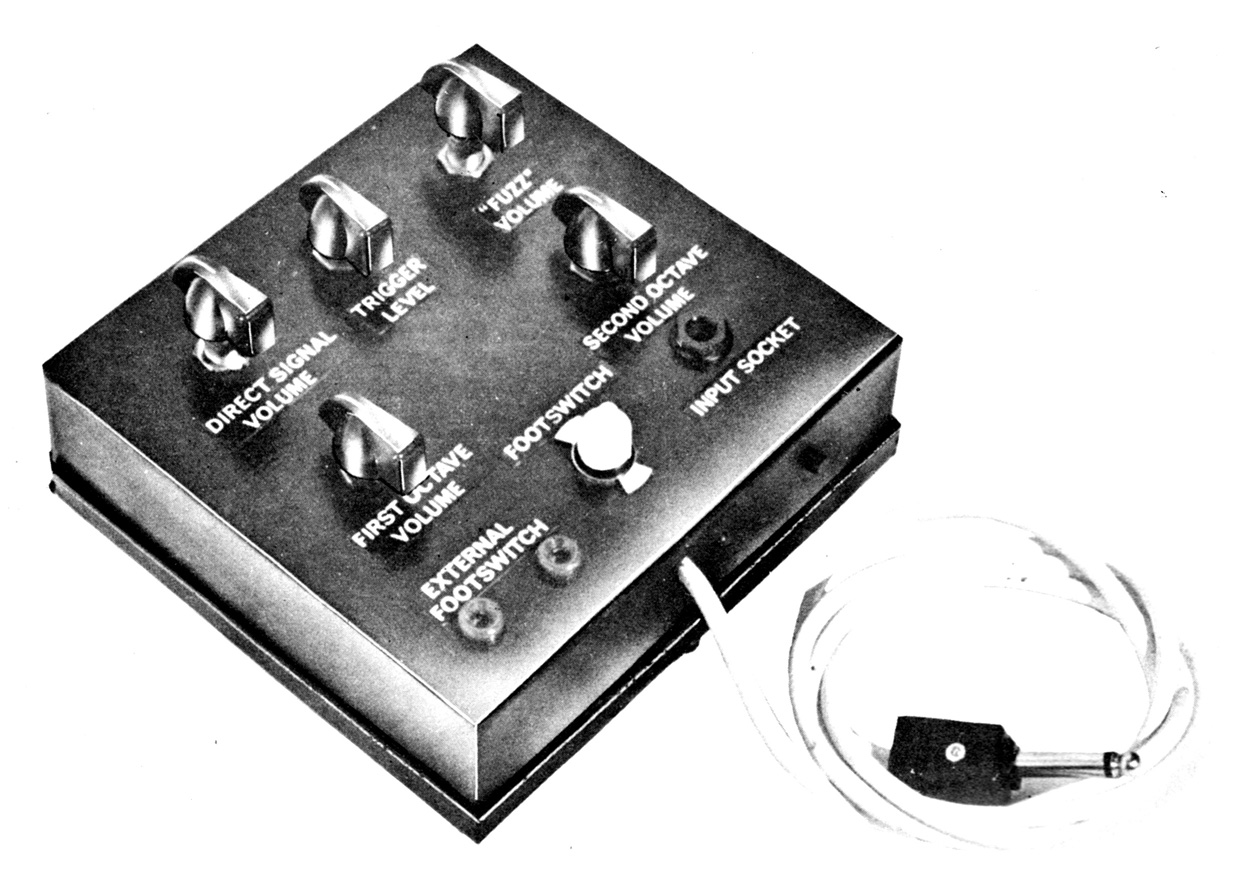
ELECTRONIC GUITAR-EFFECT INVENTIONS BY MALCOLM HAMER
This page is a brief account of the results of my interest in electronic guitar effects in the 1960s. In addition to building my own versions of well-established effects devices, such as the fuzz box (most prominently featured in 'Satisfaction' by The Rolling Stones in June 1965), I also built the following devices that were novel at the time. Articles about them were published in the UK magazine Practical Electronics. Links to PDFs of those articles appear at the end of the descriptions below.
A. THE HARMONAPHONE
The function of the Harmonaphone is to add sub-harmonics to a lead guitar to give it the kind of "full" sound that George Martin achieved in the guitar solos of early Beatles' songs such as 'A Hard Day's Night' (which was done using a piano to provide sub-harmonics for George Harrison's guitar solo). The Harmonaphone was connected between the electric guitar output and the amplifier input. It generated notes one octave and two octaves lower than any note played on the guitar and then added these on to the original signal to produce the enhanced output signal.
The full article:
The Harmonaphone by M. P. R. Hamer, Practical Electronics, February 1969 (PDF)
B. AUTOMATIC WAA-WAA OPERATION
The wah-wah pedal (sometimes spelled waa-waa) was created by Brad Plunkett at Warwick Electronics Inc. in November 1966. A patent for the pedal was filed on 24 February 1967 and, that same month, the pedal was launched as a product by Warwick's 'Vox Sound Equipment' division. It featured on a number of records that year, for example, 'Burning of the Midnight Lamp' by The Jimi Hendrix Experience. A circuit design for a wah-wah pedal was published in the July 1968 edition of the UK magazine Practical Electronics. A few days after I read the article I modified the design to automate the action of the pedal, so that the guitarist could concentrate on playing the guitar without having to bother with operating a pedal. I immediately sent a description of my design to Practical Electronics, who eventually published it a year later, in July 1969.
At the same time that I sent my design to Practical Electronics (July 1968) I also sent it to Vox to see if they would be interested in incorporating it into their wah-wah products. After four months' deliberation they wrote back to me on 7 November 1968 saying "this does not fit in with our plans for our present range of goods". Vox and others launched various forms of pedal-less wah-wah unit starting in the 1970s, but I received no further communications from Vox. I guess I should have filed a patent.
Copy of the above article, the full circuit diagram (including Baily's original circuit), and the above letter from Vox:
Article about automating a waa-waa published in Practical Electronics plus letter from Vox (PDF)
C. SITAR EFFECT
Another effects-device design that I submitted to Practical Electronics made an electric guitar sound like a sitar. This effect was achieved by feeding the sound of the guitar into a telephone earpiece and then using a second earpiece, taped face-to-face to the first earpiece, as a very-low-quality microphone from which the sitar-like sound emerged. I'm not sure of the exact date that this was published (I didn't save the whole page containing the article); but I am fairly certain it was in the second half of 1966, given that I built the device so that the group that I played in could perform The Rolling Stones' 'Paint It Black' (which featured a sitar and was released in May 1966).
Copy of the above article:
Simple Sitar, published in Practical Electronics (PDF)
LETTER TO THE EDITOR OF PRACTICAL ELECTRONICS − VIBRATO VERSUS TREMOLO
Rather than include it on my 'Letters to the Editor' page, I decided to place the following letter here, along with the other items about guitar effects. (Note: c/s = cycles per second, nowadays referred to as Hz = hertz.)